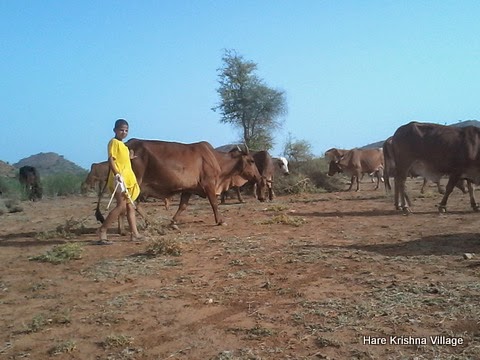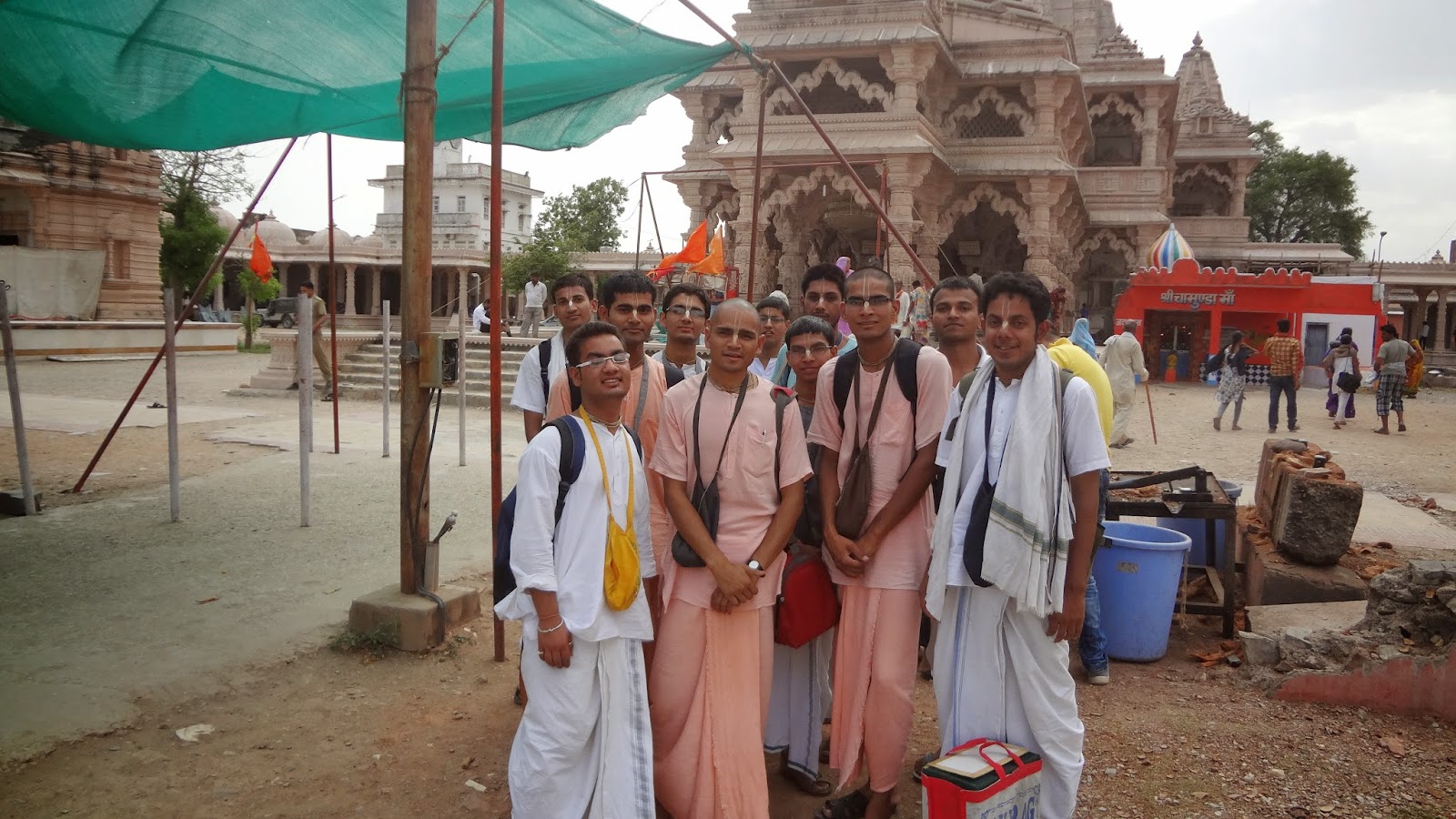Shri Raghunandan Thakur
Shri Mukunda Das, Madhab Das and Shri Narahari Sorkar Thakur were three brothers who lived in the village of Shri Khanda. Raghunandan was the son of Shri Mukunda Das. [C.C.Madhya 15]
In the house of Shri Mukunda Das, who lives at Shri Khanda, Lord Shri Gopinath is served with great attention.
One day Mukunda had to go out for some specific work so he called his son Raghunandan and asked him to serve Lord Gopinath that day. Raghunandan was only a small child at that time so his father carefully explained to him, "This Deity is in our family for many generations. He has been worshipped by my father and his father before him, and his father, on and on in this way for so many years. Just as your mother feeds you and I everyday, so also He has to be fed everyday."
He explained to Raghunandan that this is a very big responsibility and he should be very careful to give his full attention to this service. Then Mukunda went out.
Raghunandan collected the items for offering to Shri Gopinathji and entered into the Deity room. Raghunandan was at that time barely 5 years old. He tried to offer the bhoga as he had seen his father do but when he looked up after reciting some prayers he saw that the bhoga was still there. When he saw that Gopinath hadn't eaten the offering after he had imitated his father's offering procedure as best as he could remember, he became very worried. His father had impressed upon him the importance of this service and now he could understand that he wasn't doing it properly, and that his father would be displeased. Ultimately he simply requested Gopinath with tears in his eyes, "Eat! Eat!"
Gopinath became completely subjected by Raghunandan's simple request, made entirely in love, and thus He stealthily ate up everything without leaving any remnants.
After some time Raghunandan's father, Mukunda, returned and asked his son if he had done as he was told? When his son replied "Yes", then Mukunda asked him to bring some of the prasadam. Raghunandan replied, "Prasadam? I offered everything just like you told me, and Gopinath ate everything. So what should I bring you now?"
Mukunda was completely taken aback. "This boy is not naughty and is always accustomed to speak the truth. I doubt if he would have eaten everything. I wonder what actually happened?"
Musing on this matter in his mind for some days, his curiosity remained unsatisfied even after a few days time had elapsed. He got an idea and so again requested Raghunandan to offer the bhoga to Gopinath on that day. Raghunandan was very excited to hear this request and replied that he would be more than happy to make the offering since he liked to do that service so much.
On this day however, after going out of the house, he again came in by another way and remained hiding in one place.
Raghunandan was very happy to be able to serve Shri Gopinathji again. He brought everything into the Deity room and as before, he again very insistently persuaded Gopinath to take his meal. As Gopinath had eaten half of a laddu, he espied Mukunda standing in the doorway. He didn't try to cover up the fact that he had eaten what he had, but neither did he eat any more.
Seeing all this Mukunda was completely immersed in ecstatic love and picked up his son and put him on his lap. Again and again he extolled his virtues in a voice trembling with ecstasy, all the while torrents of tears of joy falling from his eyes. Even today, those who are greatly fortunate can still see that half-eaten laddu in Gopinatha's lotus hand. Thus Shri Uddhab das sings the glories of Raghunandan, who is non-different from Madan(Cupid).
Raghunandan was present at the kheturi utsob (festival).In Krishna lila he was Kandarpa manjari and/or the priya narma sakha Ujjval. In Dwaraka lila he was Shri Krishna's son Kandarpa (Pradyumna).
Raghunandan's son is Kanai Thakur. His descendants are still residing at Shri Khanda. Shri Khanda can be easily reached from Katwa by bus or train.
Raghunandan Thakur was born in the year 1432 sakabda. He appeared on the first day of Spring, Basantpancami, in the year 1432 (saka). His disappearance is on the fourth day of the bright fortnight in the month of Srabon.
Shri Vamsi Dasa Babaji Mahraja
Vamsidas Babaji was a Gaudiya Vaishnav sadhu who lived at Swarupa Gunj, Navadwip during the time of Srila Bhaktisiddhanta Saraswati Thakur. He was respected by Srila Bhaktisiddhanta, and he used to see to it that Vamsidas Babaji was provided with grains and so on by Gaudiya Matha brahmacharis.
Srila Vamsidas Babaji appeared in the village of Majidpur in the Jamalpur district of Bangladesh. Before the partition of India, this city was formerly in the district of Mymensing. His father’s name was Sanatana Malobrahma and he was previously known as Bhairava. Babaji Maharaj came to Nabadwip from East Bengal.
He lived as a total recluse, far away from the hubbub of the town in a solitary place on the bank of Ganga near Baral Ghata in Navadvipa, as if he was a mad or crazy person. His only possessions were an old kaupina, karanga and kantha. Vamsidasa Babaji lived in a world of his own. His world centered round his deities-Gaura-Gadadhara, Nitai, Radha-Krishna and Gopala. For the service of his deities he had two brass pots, some earthen pots, one plate, one glass, some small cups, pancapatra, bell and conch-shell and nothing else.
Baba passed day and night in the service of the deities and in sweet talks with Them. Early in the morning he went out from his kuti to collect flowers. Then he went for bhiksa. He returned to his kutiya about noon and made garlands from the flowers for each of the six deities. After that he would cut the vegetables. He washed each vegetable a number of times. Then he cleaned rice. He examined each grain of rice. If he found any grain from which the husk was not removed, he removed it with his own hand.
He did everything slowly, contemplating all the time the lila of Radha-Krishna or Gaura-Nitai, and singing or talking to Them. It was only late in the evening that he could cook and offer bhoga to the deities. He had no consciousness of time. Morning and evening, day and night had no meaning for him. Almost the whole night he kept awake, talking and singing.
One day, a lady selling fish approached V.B., offering him some choice type of catch. Somehow or other, the Babaji's mind became attracted to tasting the fish. But he immediately rebuked himself and became very angry. He first of all shouted at the woman to go away. Then he shouted at his deities, "How could this happen? How could this happen? I've surrendered my life to Radha Krishna, I'm under They're protection, and still this happens! Why are You not protecting me?" He went storming into his bhajan kutir. People gathered while he fussed and fumed at his Deities inside. Then he came out, bringing the Deities tied by rope, and threw Them into the Ganga. He kept the end of the rope under his foot. When one man inquired why he was doing this, the Baba threw a stone at him.
When this news reached the Gaudiya Matha, Srila Bhaktisiddhanta Thakur called his brahmacharis together and forbade them from visiting the baba again, save for one who would just deliver supplies. After a few days, he again called them together and said, "Some of you think I've stopped you from visiting babaji maharaja because he is in maya. That is not so. I’ve prevented you because you will not be able to understand this bhava and will only commit offences. So better you stay away." Later, when that one brahmachari visited, Vamsidas babaji maharaj threw a stone at him and told, "If you want to please me, then never return here again!"
Babaji never locked the door of his kutir when he went out for bhiksa or to bathe in the Gariga. When asked why he did not lock the kutir, he said, "If the owner of the house Himself does not keep a watch then what is the use of locking the house? I do not even keep the keys of the lock with me. The lock has three keys. All the three are with the three boys. One is with Gaura, one with Nitai and one with Gadadhara."
After entrusting the lock and the keys to the three “boys”, Baba used to be free from anxiety. If while he was out a cow entered the kutir and ransacked everything, he would be angry with the boys. If someone stole something from the kutir he would say, "Gaura has a soft corner for Nadiyavasis, the residents of His own Dhama. Therefore He gives things away to them. I am after all an outsider." Once a gold necklace, given by someone to Sri Gaura, was stolen, when he had gone out for bhiksa.
On returning to the kutir he kept on scolding Gaura and asking Him whom He had given away the necklace to, for about two hours. Towards the evening he got a hint. He then went to the house of the thief and asked him for the necklace. The thief pushed him down the verandah of his house. He was hurt. But he did not say anything. But how could Gaura tolerate this? The thief soon died as well as all the other members of his family.
Once Baba had to punish Gaura-Nitai for Their connivance in a theft. The two brass-pots, in which Baba' used to cook for Gaura-Nitai were stolen. How could this happen without the connivance of Gaura-Nitai? So They were punished. Baba scolded Them and did not give Them anything to eat that day. The punishment had its effect. The next day someone came quietly and delivered one of those pots. Baba said, "This small pot is Nitai's. He will be fed today. If Gaura wants to eat, He must also bring His pot." Baba always did what he said. He cooked and offered bhoga to Nitai. Gaura drew a long face as He kept looking at Nitai eating. In the meantime another man came and delivered the other pot. Baba then cooked in that pot and offered bhoga to Gaura. When Gaura also had eaten, he said with tears in his eyes, "Do I ever want to punish You? But both of You are so naughty that You always harass me. Don’t you know that I have now become old and cannot bear it all. What can I do?"
Babaji Maharaj did not stay exclusively in the Navadwip area, but also travelled to many holy places where he practiced the spiritual disciplines of bhakti-yoga. Whenever he saw a peepal tree, he would sit under it, taking it to be the Vamsi-vata under which Krishna played his flute to attract the gopis. Once he had installed himself there, it would be difficult to get him to move.
In February 1941, Vamsi Dasji left Navadwip and headed for Vrindavan. He sometimes walked, sometimes travelled by ox-cart and sometimes by rail. He first went to Katwa where he stayed for two days under a vata tree near the railway station. Then he took the train to Bhagalpur where he stayed for a day under again under a vata tree near the station and for four days by the Ganges. Then he travelled on to Gaya where he remained on the banks of the Phalgu River for three days.
He also stayed on a boat in the Ganges near Dashashvamedha Ghat in Benares for three days, spent another three days in Ayodhya by the Sarayu including three hours under a vata tree, at the Triveni confluence at Prayag for ten days, two days at the Vishram Ghat in Mathura, eight days at the Vamshivata in Vrindavan, at the Madhya-curia on the banks of the Yamuna, the Govindevji temple, Kaliya-daha, near a tamala tree on the east bank of Surya Kund at Nandagrama, two days at Pavana-sarovara and then nine days at Vamshivata Ghat in Vrindavan.
Everywhere that he went, he remained absorbed in chanting the Holy Names and meditating on Krishna’s form and pastimes. After three months, he returned to Navadwip Dhama, in the month of Jyestha.
Those who travelled with him recounted that when wandering through Vraja Mandala, he would sometimes sing songs about Krishna’s lila, sometimes glorify Navadwip Dhama, sometimes laugh madly. Sometimes, he would babble incoherently, and oftentimes he would remain completely silent.
When visiting a temple, he was often seen muttering confidentially to the deities, disclosing some personal sentiment to them. All in all, his companions were charmed by his devotional absorption. In an old Gaudiya Math weekly magazine, further accounts of Babaji Maharaj’s travels are given. It is stated there in the four years from March 1943, he travelled to Ambika Kalna, Kharagpur, Baleshvara (Balasore), Soro, Bhadrak, Khurda Road and Purushottam.
During these travels the sadhus of the Gaudiya Matha rendered great service to him. Nothing is known about Baba's life as a householder, except that he was married at an early age and his son Haricandra was nine or ten years old when he renounced the world. He went to Navadvipa around 1906.
There was a person from Navadvipa-dhama who used to come to Babaji Maharaja. One day, he thought, "I have the desire to obtain the Supreme Lord. How can I get Bhagavan?" This person came back repeatedly to see Babaji Maharaja. Finally, one day, he approached Maharaja directly.
"What do you want?" Babaji Maharaja asked him.
"I want to see Bhagavan," the man said.
Babaji Maharaja replied with only one word: " Then weep for Him!"
Babaji Maharaj’s disappearance day is on the Shukla Caturthi of Shravan.



























































